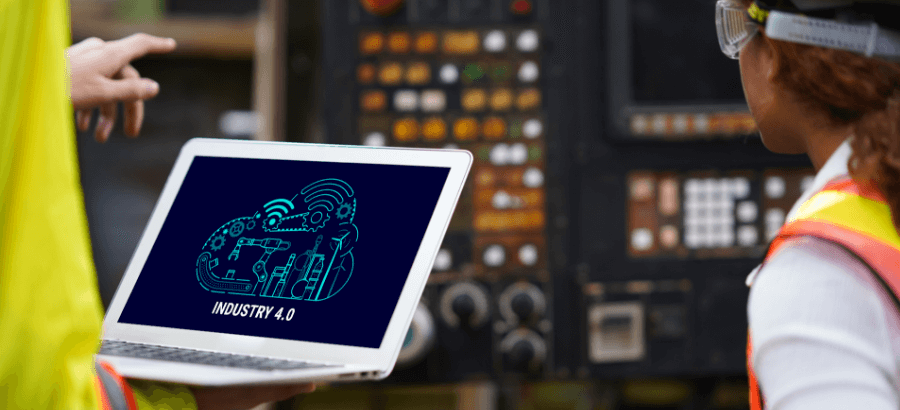‘A new, end-to-end synchronized supply network is needed, where suppliers, manufacturing sites, customers and experts’ partner efficiently within a seamless ecosystem. This supply network would be touchless and interconnected, and able to pilot quickly, learn, eliminate low-quality tasks and standardize repetitive actions. It would generate high efficiencies and optimize costs, while also leaving a smaller environmental footprint.’
While this utopia sounds far-stretched for some, it also illustrates the possibilities presented to manufacturers and distributors by Industry 4.0. The term ‘industry 4.0’ was first coined in Germany in 2011 in response to a wave of new technological innovations including advances in AI, ML and cloud computing as well as data analytics . In a nutshell, Industry 4.0 is all about the interconnectivity of machines to autonomously manage production in a flexible way. With the right technologies in place, manufacturers can operate through ongoing automation, have better visibility across the supply chain and ultimately improve productivity, reduce costs and improve the overall customer experience. And yes – achieve an end-to-end synchronized supply network!
The World Economic Forum goes on to highlight two elements that make industry 4.0 possible:
- The investment in new technologies
- The enablement and involvement of people across the organisation where continuous teaching and building new skills is the new norm, and where businesses aim for an inclusive culture of innovation, which challenges the status quo and empowers everyone to contribute with ideas to improve and simplify.
People and skills development are clearly a vital consideration. In fact, with this in mind, Australia established the Prime Minister’s Industry 4.0 Task Force and even set up Industry 4.0 TestLabs, which included Federal Government-funded pilot education and training programs in digital technologies.
While government initiatives have lent a helping hand in building the skills for tomorrow; employee 1.0 is still a big concern for global manufacturers and distributors. Businesses now have two highly integrated risks:
- The need to enable employees to be digitally savvy enough to thrive in industry 4.0.
- The need to provide an effective industry 4.0 experience.
We are now faced with a situation where employee 1.0 needs to evolve to meet industry 4.0 or risk the future of the business. Additionally, business need to enable an Industry 4.0 environment or risk not attracting or retaining the employee 4 resources it needs.
Before businesses can make that shift, leaders need to understand the differences between the various employee levels, recognize what their status of employee experience is then determine what needs to be done for both industry 4.0 and employee 4.0 to become a reality.
Employee 1.0: The manual register
Employee 1.0 runs on manual or paper-based systems and is not systemized by nature. You can imagine an employee that relies on multiple systems, that are by no means integrated. In fact, this employee is often micromanaged and not included as part of the bigger decision-making process. You will find that businesses that rely on employee 1.0 have disconnected digital initiatives that are often poorly aligned with the enterprise strategy and not focused on customer experiences.
Employee 2.0: The digital explorer
Employee 2.0 may derive more input from batch functions or focus sessions than employee 1.0. This employee operates in a business that has identified a need to develop a digitally enhanced, customer-driven business strategy, but execution is on a project basis. Progress is therefore not predictable nor repeatable.
Employee 3.0: The digital player
Employee 3.0 has access to optimized machinery and devices but may not have a full picture of what is happening across the business. Here, the manufacturing business has IT goals that are aligned at enterprise level; but not yet focused on the disruptive potential of digital initiatives.
Employee 4.0: The digital transformer
This employee has access to real-time data to turn decision-making on its head. The good news is that these employees are already conditioned to think and behave around real-time data thanks to today’s digitally savvy world and they apply these skills to the workplace. Because of this, employee 4.0 is able to identify pain points across the business and help find practical solutions.
While they work with integrated machinery and information systems, their role is still augmented, giving them the freedom to innovate. In fact, these employees work in an integrated and synergistic business environment which delivers digitally enabled product or service experiences on a continuous basis.
Businesses that empower industry 4.0 are also purpose driven. A purpose-driven organization takes on an action that is far bigger than its products and service and place the employee at the centre of success.
“The role of a leader is not to come up with all the great ideas. The role of a leader is to create an environment in which great ideas can happen.”
― Simon Sinek, Start with Why: How Great Leaders Inspire Everyone to Take Action
Building employee 4.0 to meet the factory of the future
The actualization of employee 4.0 is the ultimate goal for any business leader. To close the gap between employee 1.0 and industry 4.0, businesses need to ensure that the right skills are in place and that the best technology is available to augment the workforce.
- Skills for the future
SYSPRO’s latest global research report ‘Realigning the links of the disconnected supply chain’ revealed that only 38% of manufacturers and distributors have upskilled their staff to use new systems to improve business operations in the disruptions that have been faced over the pandemic. The study also shows that 61% of businesses had no intention of building long terms skills training programs to enable a digital workforce.
It goes without saying, that in order for the skills deficit to be reduced significantly, skills development needs to be central to a business digital transformation strategy.
When building a digital transformation strategy, business leaders should assess what type of skills are needed currently, what type of skills are needed for the future and whether the current employee base that is being recruited is ready for these changes.
Technology to augment human ability
Technologies like Enterprise Resource Planning (ERP) can also develop employee 4.0. This is because it augments human capital, and it doesn’t replace it. ERP provides a single source of truth, for real-time decision-making and gives Employee 4.0 full visibility across the factory floor.
Manufacturers are learning that ERP systems make it easier to leverage the deluge of data that’s coming in from connected sensors in their factories, inventories, and raw materials, and from signals along the supply chain. In this way Businesses can also eliminate the tracking of operations via spreadsheets, which will in turn eliminate the possibility of human error. Employee 4.0 now has the ability to focus on new innovations and thrive within a purpose-filled organization.
It is clear that Industry 4.0 is inevitable. The key to success is to ensure the right skills and technologies are in place to leverage all of the benefits associated with it. Every workday brings with it new business challenges and growth opportunities, so having a workforce that learns and adapts in real time can help build competitive advantage in the new age of Industry 4.0.






